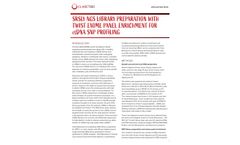apoptosis Downloads
5 downloads found
2-aminopurine (2-AP) is a potent inhibitor of double-stranded RNA (dsRNA)-activated protein kinase (PKR), a critical mediator of apoptosis. PKR is phosphorylated and activated by dsRNA and poly(I:C) [1] and contributes to the induction of type I interferons, such as IFN-β, which can further increase its expression [2]. ...
Matrix Metalloproteinases (MMPs) are a large family of endopeptidases. Collectively, MMPs can degrade all kinds of extracellular matrix proteins, and can also process a number of bioactive molecules. They are known to be involved in the cleavage of cell surface receptors, the release of apoptotic ligands, and chemokine/cytokine inactivation. MMPs are also thought to play a major role in cell ...
Basic fibroblast growth factor (bFGF) is a prototypic member of the fibroblast growth factor family. Cytokines in the FGF family possess broad mitogenic and cell survival activities (Folkman & Klagsbrun; Kimelman & Kirschner) and are involved in a variety of biological processes including cell proliferation, differentiation, survival, and apoptosis (Folkman & Klagsbrun; Klagsbrun; ...
The protein encoded by this gene is a member of the interleukin 1 cytokine family. This cytokine is produced by activated macrophages as a proprotein, which is proteolytically processed to its active form by caspase 1 (CASP1/ICE). This cytokine is an important mediator of the inflammatory response, and is involved in a variety of cellular activities, including cell proliferation, differentiation, ...
SRSLY NGS library preparation with twist exome panel enrichment for ctDNA SNP profiling. Cell-free DNA (cfDNA), found circulating in blood, originates predominantly from dying cells. In healthy individuals the vast majority of cfDNA derives from hematopoietic myeloid and lymph cells undergoing apoptosis. However, in individuals with cancer, a variable fraction of the cfDNA derives from tumor ...





